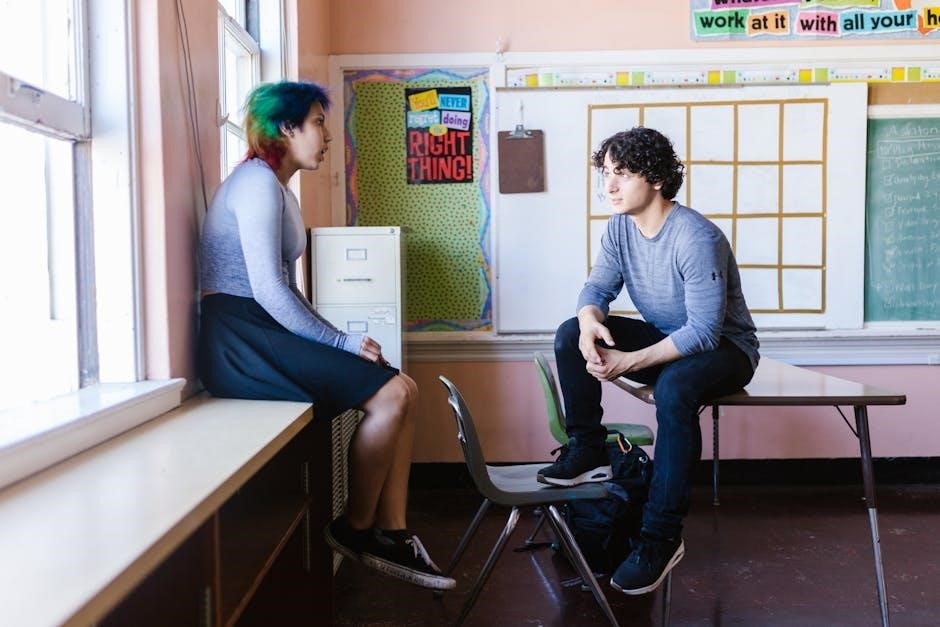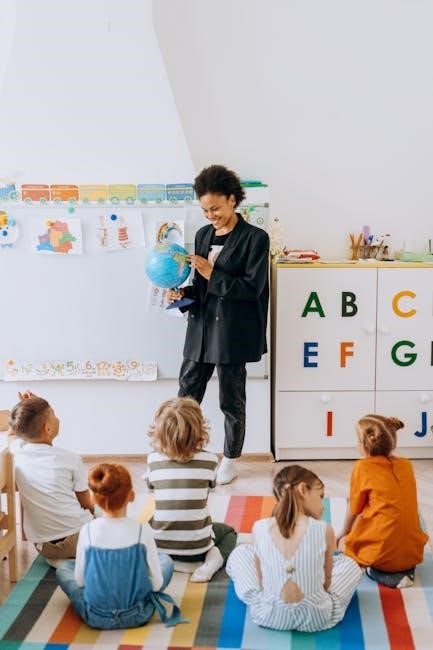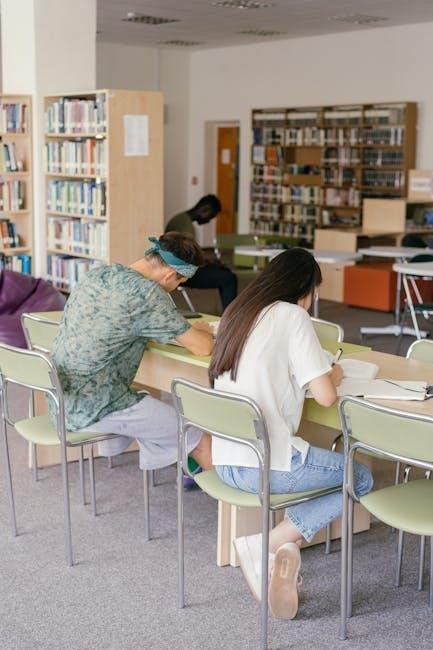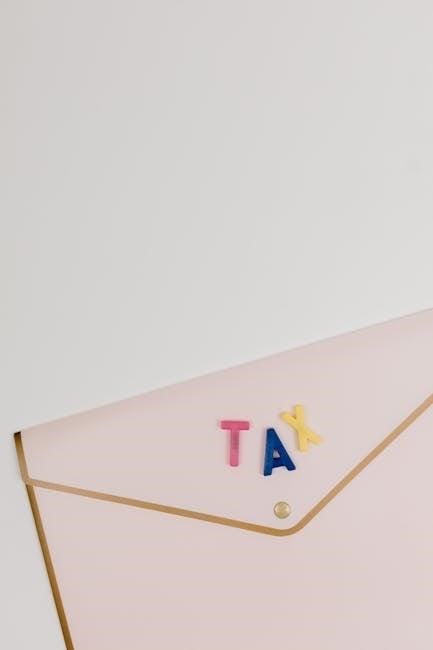This comprehensive guide provides educators with essential tools to assess and manage student behavior effectively, offering pre-formatted report cards, customizable graphs, and strategies for promoting positive outcomes.
Overview of the Book and Its Purpose
The Classroom Behavior Report Card Resource Book is designed to help educators effectively monitor and address student behaviors. It offers pre-formatted report cards, customizable graphs, and strategies for consistent assessment. The book is divided into sections covering general classroom behaviors, physical aggression, verbal behaviors, inattentive/hyperactive behaviors, socially withdrawn behaviors, and school work-related behaviors. Its purpose is to provide teachers with practical tools to track progress, set clear expectations, and foster a positive classroom environment through structured behavior management.
Importance of Behavior Management in the Classroom
Effective behavior management is crucial for creating a productive and respectful learning environment. It helps minimize disruptions, improve student focus, and ensure academic success. By implementing consistent strategies, teachers can address challenging behaviors, promote positive habits, and foster social-emotional growth. The Classroom Behavior Report Card Resource Book provides tools to monitor progress, ensuring clear expectations and fostering accountability. This approach not only supports individual student needs but also enhances overall classroom dynamics, leading to a more effective and engaging educational experience for all.

Key Features of the Classroom Behavior Report Card Resource Book
This resource offers pre-formatted teacher and student behavior report cards, customizable graphs, and both daily and weekly tracking options, providing a comprehensive and user-friendly behavior management solution.

Pre-Formatted Teacher and Student Behavior Report Cards
The resource includes pre-designed report cards for both teachers and students, covering various behavioral aspects. These templates are ready to use, saving time and ensuring consistency. Teachers can easily track and document student behavior, while student versions promote self-monitoring and accountability. The templates are structured to align with classroom expectations, making it simple for educators to implement them effectively. This feature enhances the overall efficiency of behavior management in the classroom setting, providing clear and organized documentation for all stakeholders involved.

Customizable Graphs for Behavioral Tracking

The resource offers customizable graphs to visually track student behavior over time, enabling teachers to monitor progress effectively. These graphs can be tailored to focus on specific behaviors, such as compliance, participation, or respect. By providing a clear visual representation, educators can identify trends, celebrate improvements, and address areas needing attention. This feature enhances the ability to make data-driven decisions, ensuring targeted support for students and fostering a more structured approach to behavior management in the classroom environment.
Daily and Weekly Report Card Options
The resource provides both daily and weekly report card options, offering flexibility for teachers to track student behavior. Daily cards are ideal for immediate feedback and can be sent home for parental review, while weekly cards allow for a comprehensive overview of behavior across multiple days. This dual option ensures consistent monitoring and helps identify patterns, enabling teachers to adjust strategies and support students more effectively. Both formats are designed to be user-friendly and adaptable to different classroom needs.
Types of Classroom Behaviors Addressed
The book addresses various classroom behaviors, including general conduct, physical aggression, verbal interactions, inattentive or hyperactive actions, socially withdrawn tendencies, and school work-related habits.

General Classroom Behaviors
The Classroom Behavior Report Card Resource Book addresses fundamental classroom behaviors, ensuring students meet basic expectations for respect, responsibility, and self-control. These behaviors form the foundation for a productive learning environment.
Examples include following classroom rules, staying on-task during lessons, and demonstrating positive interactions with peers and teachers. Monitoring these behaviors helps identify areas needing improvement, fostering accountability and social growth among students.
Physical Aggression
Physical aggression in the classroom is addressed through specific report cards that monitor behaviors like hitting, pushing, or throwing objects. These tools help educators identify incidents and track progress over time, enabling early intervention. By using these resources, teachers can address physical aggression effectively, fostering a safer and more respectful learning environment for all students.
Verbal Behaviors
Verbal behaviors, such as disrespectful language, shouting, or inappropriate comments, are addressed with specific report cards to monitor and improve communication skills. These tools allow teachers to assess and provide feedback on students’ verbal interactions, helping to reduce disruptive or harmful speech. The resource book includes guidelines for tracking progress and setting goals, ensuring students learn to express themselves respectfully and appropriately in the classroom environment. This fosters a more positive and inclusive learning space for everyone.
Inattentive/Hyperactive Behaviors
Inattentive and hyperactive behaviors, such as difficulty focusing or excessive restlessness, are addressed with specialized report cards. These tools help teachers monitor and provide feedback on behaviors like staying on task, following instructions, and managing impulsivity. The resource book includes guidelines for assessing these behaviors, offering strategies to improve attention and reduce disruptive actions; By tracking progress, educators can help students develop self-control and meet classroom expectations, fostering a more focused and productive learning environment for all students. This section provides tailored support for addressing these specific challenges.
Socially Withdrawn Behaviors
Socially withdrawn behaviors, such as avoiding interactions or showing reluctance to engage, are addressed with specific metrics in the report cards. Teachers can monitor and provide feedback on behaviors like initiating interactions, participating in discussions, and maintaining eye contact. The resource book offers strategies to encourage social participation and reduce isolation, helping students build confidence and connections. By tracking progress, educators can create tailored plans to support students in overcoming social withdrawal and fostering positive relationships in the classroom environment. This section emphasizes fostering social skills and inclusion.
The report cards address school work-related behaviors, such as preparedness, engagement, and task completion. Teachers can assess students’ ability to follow directions, stay on task, and meet deadlines. The resource provides tools to monitor progress in areas like organizational skills and responsibility. By tracking these behaviors, educators can identify areas for support and help students develop better work habits, fostering a stronger connection between behavior and academic success. This section emphasizes accountability and productivity in the classroom.
Benefits of Using the Classroom Behavior Report Card System
School Work-Related Behaviors
The report cards address school work-related behaviors, such as preparedness, engagement, and task completion. Teachers can assess students’ ability to follow directions, stay on task, and meet deadlines. The resource provides tools to monitor progress in areas like organizational skills and responsibility. By tracking these behaviors, educators can identify areas for support and help students develop better work habits, fostering a stronger connection between behavior and academic success. This section emphasizes accountability and productivity in the classroom.
Improved Consistency in Behavior Assessment
The Classroom Behavior Report Card System enhances consistency in behavior assessment by providing standardized tools. It reduces subjectivity in teacher ratings through pre-formatted cards and clear criteria. Customizable graphs allow educators to track behavior over time, ensuring reliable data collection. By aligning assessments with classroom expectations, the system promotes fairness and accuracy. This consistency helps teachers identify trends, make informed decisions, and support student growth effectively.
Enhanced Student Self-Monitoring
The Classroom Behavior Report Card System empowers students to take an active role in managing their behavior through self-monitoring. By completing their own behavior report cards, students develop awareness of their actions and their impact on the classroom environment. This tool fosters accountability and encourages students to reflect on their behavior, fostering self-regulation and personal growth. The system’s structure helps students track their progress, identify areas for improvement, and set achievable goals, promoting a sense of responsibility and independence in their behavioral development.
Clear Communication with Parents
The Classroom Behavior Report Card System facilitates open and consistent communication between teachers and parents. By providing detailed, objective feedback on student behavior, the report cards ensure parents are well-informed about their child’s progress. This transparency helps parents understand classroom expectations and supports their involvement in reinforcing positive behavior at home. Regular updates through daily or weekly report cards enable collaborative efforts between educators and families, fostering a unified approach to student behavior management and overall development.

Practical Tips for Implementing the Report Card System
Select the right report card for each student, use daily or weekly formats, and involve students in self-monitoring for accurate and consistent behavior tracking.
How to Select the Right Report Card for Each Student
Identify the student’s specific behavioral concerns and match them with the appropriate report card from the resource book. Choose between primary or intermediate levels based on the student’s age and understanding. Select daily or weekly formats depending on the need for frequent feedback. Consider involving students in self-monitoring by using student versions of the report cards. Ensure the selected report card aligns with classroom expectations and clearly communicates goals. Discuss the expectations and rating system with the student to promote understanding and accuracy in behavior tracking.
Strategies for Increasing the Reliability of Ratings
Develop specific, observable criteria for each behavioral goal to ensure consistency in ratings. Align ratings with classroom norms and use numerical benchmarks where appropriate. Train teachers to apply consistent standards and review ratings regularly for accuracy; Provide clear examples of what each rating represents, such as a 9-point scale, to minimize subjective interpretations. Encourage teachers to document instances of behaviors to support their ratings, enhancing objectivity and reliability over time.

Integrating Report Cards into Classroom Management Plans

Integrate behavior report cards seamlessly into classroom management plans by aligning them with classroom expectations and rules. Use the cards to monitor progress, set clear behavioral goals, and provide consistent feedback. Incorporate student self-monitoring as part of a broader management strategy to encourage accountability. Share report cards with parents to foster collaboration and ensure coherence in behavior support. Regularly review and adjust management plans based on report card data to maintain a structured and positive learning environment.
The Classroom Behavior Report Card Resource Book is a valuable tool for educators, offering comprehensive strategies and customizable templates to effectively manage and improve student behavior.

Advantages of the Classroom Behavior Report Card Resource Book
The resource book offers numerous advantages, including consistent behavior assessment, enhanced communication with parents, and customizable tools for tracking progress. It provides pre-formatted report cards and graphs, saving time for educators. The inclusion of daily and weekly options allows for flexible monitoring of student behavior. Additionally, it promotes student self-monitoring and accountability, fostering a positive classroom environment. These features make it an indispensable tool for effective behavior management and academic success.
Final Thoughts on Effective Behavior Management
Effective behavior management is crucial for fostering a productive and respectful learning environment. By using tools like the Classroom Behavior Report Card Resource Book, educators can consistently assess and address student behaviors, promoting positive outcomes. Encouraging self-monitoring and clear communication with parents further enhances these efforts. Implementing such strategies not only supports individual student growth but also contributes to a well-managed classroom, ensuring all students can thrive academically and socially.
